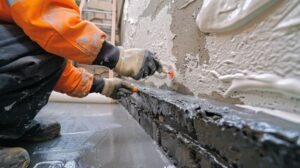New Garage Doors Yukon OK has evolved into key components of home design and security. They’re now available in various types, materials, and features to complement any architectural style.
Steel is the most popular choice due to its durability and low cost. It’s also a good insulator, keeping cold air from blowing in during the winter.

When cars first became widely used, homeowners needed a place to store them. At that time, garages were often sheds or barn-like structures with doors that swung open like traditional barn or carriage house doors. But these were bulky, heavy, prone to wear and tear from the elements, and would not open when snow or other impediments were present.
As car ownership continued to grow, people were looking for a better solution to protect their vehicles and make them easier to access. In 1921, a man named C.G. Johnson stepped forward with the answer, and his upward-acting garage door changed the way people stored their vehicles forever.
The new garage door worked by sectioning the doors into a series of hinged sections that folded around a corner, so the door could fit the entire width of a garage and be opened and closed without being blocked by snow or other objects. It also required less space for operation, which meant garages could be much smaller – and therefore more affordable.
Johnson’s invention made the garage a staple of American home life, and he went on to create an electric opener in 1926. Over the decades, these innovations and others like them helped garages become safer and easier to operate. However, even with the advent of safety sensors and automated systems, accidents involving garage doors do happen. In fact, one study found that a garage door can exert up to 130 pounds of force on someone’s arm or leg when it closes.
Today, garages are a popular addition to most homes and are available in many different styles and materials. But no matter what style of garage door you choose, remember that a properly installed and maintained garage will increase your home’s value and add both convenience and protection for your vehicle. So, if you’re in the market for a new garage door, don’t settle for anything less than a professional installation. Richards-Wilcox Doors has been a leader in the industry for over 25 years and can help you find the perfect door to meet your needs.
Materials
The material used to create a garage door can influence how long it lasts and how much maintenance is required to keep it in good working order. Steel and aluminum doors are a popular choice because of their balance of durability, affordability and security. Wood, fiberglass, and aluminum composite doors offer a range of aesthetics while still being resistant to rust and other weathering effects. Wind load doors, which are essential in hurricane-prone areas, have a more limited market and require specialized installation and additional homeowner’s insurance costs.
Single-panel garage doors swing up and overhead on a hinge on each side to open. They are less expensive than sectional options and work well in homes with small or no garage clearance outside the door opening. However, because the swing-up arc occurs partially outside the garage, vehicles may need to move back several feet before opening the door.
A traditional choice that is highly valued for its beauty and craftsmanship, wood garage doors are also resistant to rotting, warping and insect damage. They do, however, need to be repainted or restained every few years, and are more susceptible to dents than other materials.
An affordable and durable alternative to wood, aluminum garage doors have a modern look that complements many architectural styles. They are rust-free, easy to operate manually or with an electric opener, and can be customized with a variety of glass window options for natural light and visual appeal.
Fiberglass and aluminum composite doors have an attractive wood-like appearance, making them a popular choice for homeowners looking for a blend of durability and style. They are lightweight, making them easier to maneuver and install than other types of garage doors. They are also insulated, which can improve energy efficiency and reduce noise levels.
Steel is a popular choice because it resists rust and corrosion. It is also an insulator, and can be fitted with additional insulation options to improve thermal efficiency in cold climates. It is not a natural insulator and does not withstand harsh environments like rainy or salty climates as well as other materials.
Styles
Many different garage door styles are available for your home. Each offers a different aesthetic that can accentuate your house’s beauty and personality. Choosing the right style requires careful consideration and knowledge of your preferences. Take advantage of online design tools to streamline your search and make a decision you can be confident about.
Traditional panel garage doors are a classic choice. These doors are sturdy, low maintenance and offer an attractive appearance that complements most homes. They can also improve the energy efficiency of your home by insulating its outer layers. If you prefer a contemporary look, consider a modern aluminum-and-glass garage door. These doors provide a sleek, sophisticated appearance and are available in a wide variety of color options.
Another type of traditional garage door that’s making a comeback is the carriage-style garage door, which resembles the doors of old horse-drawn carriage houses. This style is often used with historic or traditional-style homes, but it can also add character to a contemporary or modern home. Some manufacturers offer this door with a window design, and it can be custom-ordered to match your home’s specific architectural features.
A louver-style garage door is a great option for colonial, farmhouse or coastal homes. These doors feature horizontal slats to allow for plenty of natural light and fresh air. Many models are constructed from steel for durability, but molded composite overlays and cladding can be molded from real wood pieces to achieve the most authentic look. These doors are usually finished with an epoxy coating that protects them from rust and corrosion.
If you’re looking for a modern garage door with an elegant, European-inspired aesthetic, consider a wrought iron door. These doors are crafted from high-quality steel with a heavy-duty, three-layer structure that includes an insulation layer and ToughGard backing. Some models include decorative wrought iron details and windows for a truly eye-catching appearance.
If you’re looking for a contemporary garage door with smart technology integration, consider a steel or aluminum-and-glass model. These doors feature a sleek, minimalist design and can increase your home’s security by encasing the door opening in tempered glass panels. They are available in a variety of color options and can be customized with windows or other embellishments.
Installation
The garage door is a key component of your home’s entryway. You must choose the right one to fit your needs and complement your exterior. A quality door will increase your home’s curb appeal and add value to it. You can install a new garage door yourself or hire a professional to do the job. The process involves measuring the size of the opening and ordering panels that fit it perfectly. It is recommended that you use a tape measure to carefully record the length and width of the opening. When ordering the panels, be sure to order them slightly smaller than your measurement. This will ensure that the panel fits well in the opening without any gaps.
Before starting the installation, you should make sure that you have all the tools and parts needed. Depending on your project, you might need extra hands to help lift and position the panels. In addition, you may need a leveler and shims to even out the sides of the door. Using the correct materials is also important. For instance, if you live in a coastal area, consider choosing fiberglass or vinyl doors to resist corrosion. If energy efficiency is a priority, look for insulated options.
Start with the bottom panel by placing it exterior-side down on a workbench, sawhorses or cardboard. Lay down rubber weather stripping to prevent moisture from leaking into the garage. Next, place the bottom brackets over the lower corners of the panel and secure them with lag screws. Shims are small wood strips you can use to level out uneven sides of the panel. Purchase a pack of them at your local home improvement store.
Once you’ve installed the bottom panel, you can move on to the rest of the door. Before you do, however, be sure to consult the owner’s manual for any special installation instructions. It is also a good idea to check online reviews of the company you are working with. Look for a garage door dealer with excellent customer feedback.
Before you attempt to remove an old extension spring, be aware that the springs are under tremendous tension and can cause serious injuries. Relieving the tension requires a heavy-duty wrench. If you don’t feel comfortable doing this, call a professional.








